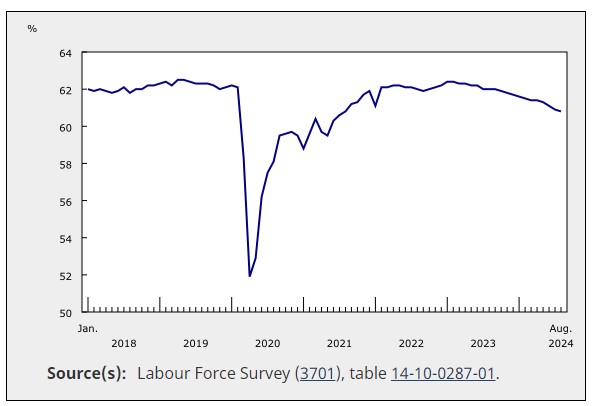Canada's job market struggles with slow growth and rising unemployment

Statistics Canada released its Labour Force Survey for August, and the numbers show an uptick in Canada's unemployment rate, to 6.6% -- a signal that the labour market continues to struggle.
While 22,000 new jobs were added, it wasn’t enough to keep pace with the growing population, according to Brendon Bernard, Senior Economist at Indeed.com.
“In a familiar pattern, lacklustre job gains in August were easily swamped by rapid population growth, an ongoing sign of deteriorating conditions,” said Bernard.
“The wrinkle this month was that the labour force participation rate ticked up, and as a result, the unemployment rate rose 0.2 percentage points to 6.6%, the highest outside of the pandemic since the first half of 2017.”
Tough summer for young job seekers
For students and young workers, the summer of 2024 was particularly rough.
The unemployment rate for students averaged 16.7% between May and August, up from 12.9% the previous year. Black students were hit hardest, with their unemployment rate soaring to 29.5%, up dramatically from 19.4% in 2023.
Layoffs rate remained low, meaning more vulnerable job seekers were hit hardest by rising unemployment.
“The tough market for job seekers hasn’t particularly impacted job security, as layoff rates also held low,” Bernard explained.
“The dichotomy between the two has meant the impacts of the labour market downturn have been particularly sharp on groups more on the margins of employment, while those in stable jobs are faring better. Among the consequences was a particularly weak summer job market for returning students.”

Source: Statistics Canada
Youth unemployment overall rose to 14.5% in August, with young men especially impacted, StatsCan reported. Their jobless rate jumped to 16.3%, reflecting the broader slowdown in hiring for younger workers.
Meanwhile, women and men in their prime working years (25 to 54) are feeling the effects of the current job market differently, StatsCan reported.
While core-aged women added 20,000 jobs in August, men in the same age group saw their unemployment rate climb to 5.7%. Older men (55+) didn’t fare much better, with their unemployment rate rising to 5.5%.
Which sectors are seeing gains and losses?
Some industries saw a boost in August. Educational services led the way, adding 27,000 new positions, a solid 1.7% increase.
The health care and social assistance sector also saw growth, with 25,000 jobs added. These sectors have been on a positive trajectory for a while now, with health care leading employment gains over the last 12 months.
On the flip side, several key industries took a hit. Jobs in “other services” dropped by 19,000, while professional, scientific, and technical services lost 16,000 positions. The utilities and natural resources sectors also faced challenges, shedding nearly 13,000 jobs between them.
One of the more concerning trends in August was the shift from full-time to part-time jobs. While part-time work grew by 66,000 positions, full-time employment dropped by 44,000.
“Focus on paychecks has taken a back seat in recent months, not only because of the weaker headline job numbers, but also because strong wage gains haven’t precluded inflation from easing, nor the Bank of Canada from cutting rates,” said Bernard.
Wage growth: good news, but not for everyone
Even though the job market is sluggish, wages continued to climb. Average hourly wages rose 5% year-over-year in August, reaching $35.16, helping workers keep up with rising living costs.
However, not everyone saw these wage gains. Recent immigrants (those who’ve been in Canada for less than five years) saw their wages actually decline by 1.3%, according to StatsCan.
Meanwhile, Canadian-born workers and immigrants who have lived in the country for over five years enjoyed more substantial wage increases of around 6%.
Job growth didn’t look the same everywhere. Alberta saw the largest gain with 13,000 new jobs in August, while Nova Scotia and Manitoba added 5,000 and 4,400 jobs, respectively. But not every region saw improvement—Newfoundland and Labrador lost 2,400 jobs, pushing the province’s unemployment rate to 10.4%.
In terms of cities, Windsor posted the highest unemployment rate among Canada’s major urban areas at 9.2%, followed by Edmonton at 8.6%. At the other end of the spectrum, Victoria had one of the lowest unemployment rates, sitting at just 3.3%.




